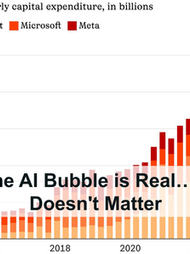AI's Impact on Jobs is More Nuanced Than Predicted
- Adrien Book

- Dec 4, 2023
- 3 min read
As technology becomes more deeply integrated into everyone’s daily life, the growing prominence of AI has sparked extensive discussions about its impact on the job market. This is not new, but has recently reached a fever pitch, as Open AI’s chatGPT has made AI’s potential much easier to grasp. Most people (myself included) seem to think that AIs will replace jobs en masse. Why wouldn’t it, since it can do the exact same tasks a human can, sometimes better?
Stefania Albanesi, António Dias da Silva, Juan Francisco Jimeno, Ana Lamo, and Alena Wabitsch, who recently authored a paper titled “Reports of AI ending human labour may be greatly exaggerated”, seem to think otherwise. The paper explores the effects of AI-enabled technologies on jobs and wages in 16 European countries from 2011–2019. It employs data from Eurostat’s Labour Force Survey and uses two proxies to measure potential AI-enabled automation: the AI Occupational Impact (“which links advances in specific applications of AI to abilities required for each occupation”) and a measure of “exposure” to AI.
Intriguingly, the study found that occupations more exposed to AI technologies actually saw an increase in employment share. Specifically, a 25-percentile increase in AI exposure correlated with a 2.6% to 4.3% rise in sector-occupation employment share. This finding contradicts the popular belief that AI predominantly replaces human labor. Instead, it suggests that AI may complement or even boost employment in certain sectors.
Key take-aways from the study
AI-Exposed Occupations will see increased employment, not the other way around. The research shows a positive correlation between AI exposure in specific industries and employment, debunking the myth of widespread job losses due to AI. This suggests that AI may complement rather than replace human labor in certain sectors.
High-Skilled Jobs will be more favourably impacted than previously thought. The study indicates that high-skilled jobs are more likely to benefit from AI technologies, challenging the notion that AI primarily threatens low-skilled labor. This shift may lead to a reevaluation of skill development and education systems.
Not all places will be similarly impacted. The impact of AI on employment varies significantly across different European countries, highlighting the influence of economic factors like technology diffusion and regulatory environments on the integration of AI in the workforce.
What do we do with that information?
Promote skills development and education reform: Focus on upskilling and reskilling programs to prepare the workforce for AI-driven changes. This includes expanding education in STEM fields and promoting continuous learning.
Create national policy frameworks for AI integration: Develop comprehensive policies that encourage innovation while ensuring that the workforce adapts to technological changes. This especially includes labor regulations that protect workers while fostering a tech-friendly environment (easier said than done!).
Continuously investment in AI Research and Development: Encourage public and private sector investment in AI to harness its potential for creating new job opportunities and enhancing productivity. Many countries say they do this… but few are really doing it (US, China).
Too soon to draw conclusions
While the paper offers insightful perspectives, it also has limitations. The focus on European countries may not fully encapsulate global trends.
The study’s time frame (2011–2019) also does not reflect the very latest AI advancements and their impact (think ChatGPT, its cousins, and GenAI as a whole).
Additionally, the paper’s less conclusive findings on wage growth and the varied impact across countries suggest that the full story of AI’s impact on the labor market is still unfolding.

The paper provides a hopeful perspective on the future of AI and employment. It suggests that rather than fearing AI as a job destroyer, we should embrace it as a catalyst for job transformation and creation.
As we continue to create and implement this new technology, it’s crucial to foster a symbiotic relationship between AI and the workforce, ensuring that the evolution of technology continues to enhance, rather than undermine, human labor.
Good luck out there.
![13 Highest Paying Jobs of the Future [2040 Edition]](https://static.wixstatic.com/media/d2c101_b67919c221ff47a2b584e4e169e50813~mv2.png/v1/fill/w_900,h_539,al_c,q_90,enc_avif,quality_auto/d2c101_b67919c221ff47a2b584e4e169e50813~mv2.png)

























Auto shipping providers understand the importance of customer trust. They conduct thorough inspections before and after each shipment to verify the vehicle’s condition. Insurance coverage adds extra security, ensuring clients are protected against unexpected damage. Many companies provide detailed tracking links that asaptransportsolutions allow customers to follow the journey in real time. This transparent communication helps build confidence and ensures a stress-free shipping process for all clients.
Dive into the chaotic world of Ragdoll Archers! This game lets you challenge friends or AI in hilarious physics-based battles. Master your bow, launch your ragdoll character, and dominate the arena. Play Ragdoll Archers online for a ridiculous showdown where anything can happen!
Thank you for your wonderful posts, blogger! I always enjoy your content and hope this site continues to thrive. I'd also like to share a game I've been playing a lot lately: Drift Boss play online.
Drive Mad unblocked isn’t just fun—it’s a heart-racing driving test: get your tiny car to the finish, and while picking up the game is simple, the unexpected hurdles in each level make mastering these crazy tracks a true adventure!
toto slot, toto slot, toto slot, toto slot, toto slot, raja168, raja168, raja168, raja168, raja168, toto slot, toto slot, toto slot, toto slot, toto slot, toto slot, toto slot, toto slot, toto slot, raja168, raja168, toto slot, toto slot, toto slot,